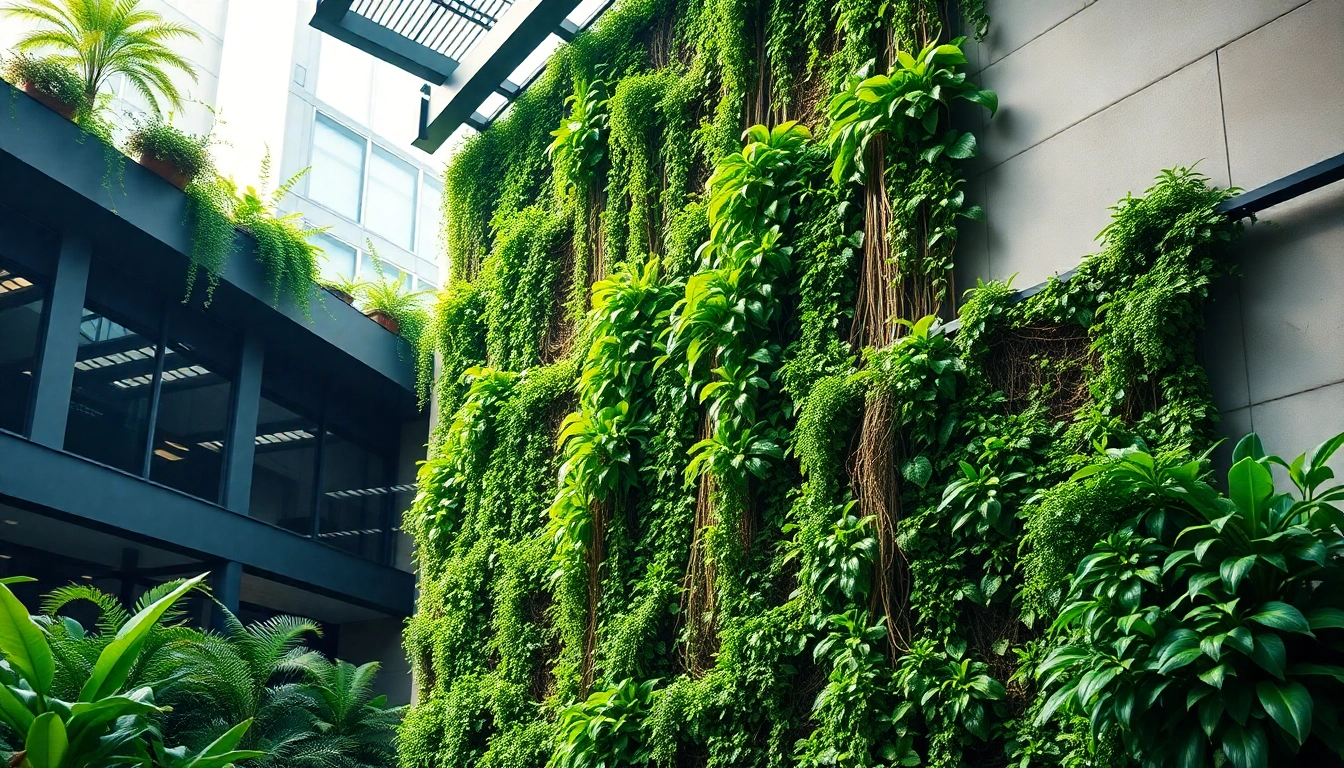Understanding Vertikale Gärten
Definition and Importance of Vertikale Gärten
Vertikale Gärten, or vertical gardens, are an innovative gardening solution that allows for the cultivation of plants in a vertical space rather than using traditional horizontal plots. This design utilizes walls, fences, or specially constructed structures to maximize the use of space, particularly in urban environments where land is limited. The importance of vertikale Gärten extends beyond aesthetics; they offer a host of environmental benefits, enhance air quality, increase biodiversity, and contribute to urban heat mitigation. Furthermore, they can transform seemingly unused spaces into lush, green areas that promote well-being and relaxation.
Benefits of Vertical Gardening for Urban Spaces
As cities continue to expand and the available ground space diminishes, vertical gardening presents a practical solution to several urban challenges:
- Space Optimization: Vertical gardens can be integrated into any vertical surface, such as walls, balconies, and rooftops, making them ideal for small living spaces.
- Improved Air Quality: Plants play a crucial role in filtering air pollutants and providing oxygen, making vertical gardens a natural air purifier.
- Noise Reduction: Green walls can absorb sound, helping to lessen urban noise pollution.
- Urban Heat Island Mitigation: The presence of vegetation in cities can help lower ambient temperatures, combating the urban heat island effect.
- Increased Biodiversity: Vertical gardens provide habitats for various species, enhancing urban biodiversity.
The infusion of greenery in densely populated areas promotes a sense of tranquility and connection to nature that is often lacking in urban environments. For additional resources on incorporating these elements into your space, explore more about vertikale Gärten.
Key Plants for Successful Vertikale Gärten
Choosing the right plants is pivotal for the success of a vertical garden. Factors such as climate, sunlight, and maintenance requirements must all be considered. Some key plant species popularly used in vertikale Gärten include:
- Succulents: These are hardy and require less water, making them ideal for beginners.
- Herbs: Rosemary, thyme, and basil can thrive in vertical gardens, adding both beauty and functionality.
They can also be harvested for culinary uses. - Flowering Plants: Petunias, geraniums, and begonias bring color and vibrancy to the design.
- Ferns: Robust varieties like Boston ferns are excellent for shadier spots.
- Vining Plants: Plants like ivy and philodendron lend a dynamic verticality that enhances the garden’s depth.
When selecting plants, consider local climate conditions, the amount of sunlight the location receives, and the ease of access for maintenance.
Designing Your Vertikale Gärten
Choosing the Right Location and Structure
Designing a vertical garden begins with choosing the right location. Factors such as light exposure, wind patterns, and accessibility for maintenance play critical roles:
- Sunlight: Most edible plants and flowering varieties require at least six hours of direct sunlight per day.
- Wind Protection: Vertical gardens exposed to strong winds may require additional support or protective barriers.
- Accessibility: Ensure the structure allows access to all plants for maintenance purposes.
Structures can range from DIY frameworks to commercially available vertical garden systems. Consider using materials that are both durable and lightweight to reduce strain on the walls and support structures.
Integrating Lighting and Irrigation Systems
Proper irrigation and lighting systems are essential for maintaining healthy plants in vertical gardens. Many vertical gardening systems incorporate built-in irrigation, using drip systems or self-watering technologies:
- Irrigation: Drip irrigation is efficient and conserves water, providing moisture directly at the root zone.
- Lighting: For indoor vertical gardens, consider LED grow lights that can supplement natural sunlight, particularly in low-light conditions.
When designing the irrigation system, ensure it is easy to maintain and can be adjusted based on seasonal changes in plant needs.
Color Schemes and Textures in Vertical Gardens
Creating an appealing aesthetic requires careful consideration of color schemes and plant textures. Here are some design principles to keep in mind:
- Monochromatic Schemes: Using various shades of a single color can create a cohesive and calming effect.
- Complementary Colors: Pairing contrasting colors can add vibrancy and excitement to the design.
- Textural Contrast: Mixing different leaf shapes and sizes enhances visual interest, with broad leaves complementing the fine textures of ferns or succulents.
Experiment with arranging plants based on their growth habits and visual appeal to achieve a balanced and structured composition.
Maintenance Tips for Long-Lasting Vertikale Gärten
Watering and Nutrient Management
Proper watering and nutrient management are paramount for the health of vertical gardens. The following guidelines can significantly affect plant growth:
- Watering: Monitor soil moisture regularly. Overwatering can lead to root rot, whereas underwatering can cause stress.
- Nutrient Management: Utilize organic fertilizers and supplements that can enhance plant growth without harming the environment.
Consider supplemental feeding of plants, especially during the growing season, to ensure they receive adequate nutrients.
Common Pests and How to Handle Them
Vertical gardens can attract pests just like traditional gardens. Familiarizing yourself with common pests and developing a proactive management plan can help maintain plant health:
- Identify Pests: Regularly inspect plants to catch infestations early.
- Natural Remedies: Employ organic pest control methods such as neem oil or insecticidal soap, which are effective against many common pests like aphids and spider mites.
Encouraging beneficial insects, such as ladybugs, can also help maintain a balanced ecosystem within your vertical garden.
Seasonal Care Strategies for Vertical Plants
Vertical gardens require seasonal adjustments to thrive throughout the year:
- Spring: Focus on planting and encouraging growth through appropriate fertilization and pest control.
- Summer: Monitor water exposure and humidity regularly, ensuring plants are well-hydrated.
- Fall: Prepare for the cooler months by pruning back any overgrowth and transitioning to winter-friendly plants.
- Winter: Protect sensitive plants from frost and consider adjusting the irrigation strategy based on reduced growth rates.
Document your seasonal care routine to refine your strategy over time, ensuring optimal plant health.
Inspiring Examples of Vertikale Gärten
Residential Vertikale Gärten That Impress
Numerous homeowners have transformed their living spaces with stunning vertical gardens. These examples showcase creativity and innovation:
- Urban Balconies: Many urban dwellers are utilizing their balcony railings to create lush vertical displays of cascading plants.
- Vertical Succulent Walls: A wall covered in an array of colorful succulents not only looks fantastic but also requires minimal maintenance.
Inspiration can also be derived from public gardens or local garden centers which might showcase models of vertical gardens.
Public Spaces Featuring Beautiful Vertical Gardens
Public installations of vertical gardens often serve as educational tools while also beautifying the urban landscape:
- Museum Gardens: Several contemporary art museums incorporate vertical gardens in their designs to create immersive experiences for visitors.
- Parks and Plazas: Urban parks featuring vertical installations not only provide beauty but also serve environmental functions like cooling and air purification.
These installations encourage community engagement and promote awareness of sustainable gardening practices.
Innovative Commercial Vertikale Gärten Designs
Businesses are increasingly adopting vertical gardens for branding and environmental consciousness:
- Office Buildings: Many modern corporate offices showcase vertical green walls to improve employee well-being and productivity.
- Restaurants: Establishments with vertical gardens often use them to grow their own herbs and vegetables directly on-site, emphasizing farm-to-table dining.
These designs not only enhance visual appeal but also contribute to the companies’ sustainability stories.
Measuring Success of Your Vertikale Gärten
Assessing Plant Health and Growth Metrics
The success of a vertical garden is measured by several key indicators of plant health and growth. Regular assessments should include:
- Growth Rate: Monitor how quickly plants are growing—speed and vigor can indicate nutrient sufficiency.
- Leaf Health: Check for coloration, texture, and any signs of pests or diseases.
Utilizing growth journals can help track progress, adjustments, and outcomes over time.
Evaluating Aesthetic Appeal and User Satisfaction
While plant health is critical, aesthetic appeal and user satisfaction are equally important:
- User Feedback: Regularly gather feedback from household members or visitors to gauge their impressions of the garden’s beauty.
- Photography: Documenting the garden’s evolution can help visualize aesthetic improvements and inform future design decisions.
A well-maintained vertical garden should evoke positive emotional responses, contributing to a sense of pride and ownership.
Tips for Future Improvements and Expansion
Continuous improvement is vital for maintaining a successful vertical garden. Consider these tips:
- Experimentation: Always try new plants or design techniques to keep the garden fresh and engaging.
- Research: Stay updated on vertical gardening trends and new technologies that may enhance your garden’s efficiency.
Reflecting on successes and failures allows for iterative enhancements, leading to a more thriving garden over time.


